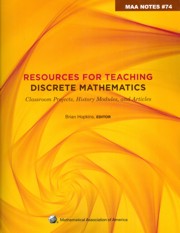Book contents
- Frontmatter
- Introduction
- Dedication
- Contents
- I Classroom-tested Projects
- II Historical Projects in Discrete Mathematics and Computer Science
- III Articles Extending Discrete Mathematics Content
- IV Articles on Discrete Mathematics Pedagogy
- Guided Group Discovery in a Discrete Mathematics Course for Mathematics Majors
- The Use of Logic in Teaching Proof
- About the Editor
Guided Group Discovery in a Discrete Mathematics Course for Mathematics Majors
from IV - Articles on Discrete Mathematics Pedagogy
- Frontmatter
- Introduction
- Dedication
- Contents
- I Classroom-tested Projects
- II Historical Projects in Discrete Mathematics and Computer Science
- III Articles Extending Discrete Mathematics Content
- IV Articles on Discrete Mathematics Pedagogy
- Guided Group Discovery in a Discrete Mathematics Course for Mathematics Majors
- The Use of Logic in Teaching Proof
- About the Editor
Summary
Introduction
In this article we discuss the use of guided group discovery in Oregon State University's discrete mathematics course for math majors. Since Fall 2003 this course has been taught at Oregon State using an ongoingmodification of Kenneth P. Bogart's successful group discovery method and notes [2], “Teaching Introductory Combinatorics by Guided Group Discovery.” Section 2 summarizes Ken's notes and method, and Sections 3 and 4 respectively contain the adaptation of his notes and the implementation of his method at Oregon State.
Ken's prototype was a small elective course in which the average entering student was very motivated to learn the material. In our department the course is required, and it is financially unrealistic for us to expect either very small classes or in-class assistance from a senior student. We think our modification is sufficiently general that it can be successfully used by other mathematics departments with similar student demographics. Since the adaptation is an ongoing project, the interested reader is referred to [6] for current information on its status.
Ken generously served as a consultant for our adaptation of his method, both informally in Fall 2003 and during the first year of the grant. We are grateful for his help.
A Short Overview of the Bogart Course
The goal of Ken's project was to design notes and a method for teaching enumerative combinatorics in which “a large majority of the students would learn a large majority of the material of beginning combinatorics.”
- Type
- Chapter
- Information
- Resources for Teaching Discrete MathematicsClassroom Projects, History Modules, and Articles, pp. 305 - 312Publisher: Mathematical Association of AmericaPrint publication year: 2009

